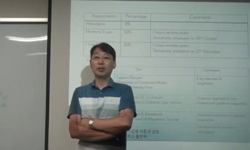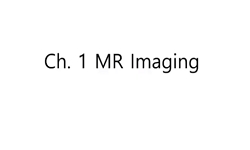Objective: To evaluate the secretory function of parotid glands by dynamic magnetic resonance (MR) sialography and determine the clinical performance of this technique in diagnosing and evaluating Sjögren’s syndrome (SS) patients. Materials and Me...
http://chineseinput.net/에서 pinyin(병음)방식으로 중국어를 변환할 수 있습니다.
변환된 중국어를 복사하여 사용하시면 됩니다.
- 中文 을 입력하시려면 zhongwen을 입력하시고 space를누르시면됩니다.
- 北京 을 입력하시려면 beijing을 입력하시고 space를 누르시면 됩니다.



Quantitative Analysis of Parotid Gland Secretion Function in Sjögren’s Syndrome Patients with Dynamic Magnetic Resonance Sialography
한글로보기https://www.riss.kr/link?id=A106063506
-
저자
Simin Liu (Tongji Hospital, Tongji Medical College, Huazhong University of Science and Technology) ; Weiwei Chen (Tongji Hospital, Tongji Medical College, Huazhong University of Science and Technology) ; Min Wang (Tongji Hospital, Tongji Medical College, Huazhong University of Science and Technology) ; Tong Wu (Tongji Hospital, Tongji Medical College, Huazhong University of Science and Technology) ; Lingli Dong (Tongji Hospital, Tongji Medical College, Huazhong University of Science and Technology) ; Chu Pan (Tongji Hospital, Tongji Medical College, Huazhong University of Science and Technology) ; Wenzhen Zhu (Tongji Hospital, Tongji Medical College, Huazhong University of Science and Technology)
- 발행기관
- 학술지명
- 권호사항
-
발행연도
2019
-
작성언어
English
- 주제어
-
등재정보
KCI등재,SCIE,SCOPUS
-
자료형태
학술저널
-
수록면
498-504(7쪽)
-
KCI 피인용횟수
2
- DOI식별코드
- 제공처
-
0
상세조회 -
0
다운로드
부가정보
다국어 초록 (Multilingual Abstract)
Objective: To evaluate the secretory function of parotid glands by dynamic magnetic resonance (MR) sialography and determine the clinical performance of this technique in diagnosing and evaluating Sjögren’s syndrome (SS) patients.
Materials and Methods: This study enrolled 29 healthy volunteers (25 women and 4 men; mean age, 34.8 ± 6.3 years; age range, 26–47 years) and 25 primary SS (pSS) patients (23 women and 2 men; mean age, 37.7 ± 7.9 years; age range, 25–50 years) with decreased secretory function. The volume of the parotid gland ducts was precisely measured for both groups at single pre- and 6 post-gustatory-stimulated phases. Time-dependent volume change ratio curves were generated, four parameters were derived from the curves: the slope of the increase in the first post-stimulation phase (slope1st), the peak value, the time-to-peak, the total saliva secretion post-stimulation. All values were used to quantitatively evaluate the secretory function of the parotid gland. The repeated measurement analysis, Mann-Whitney U test and receiver operating characteristic curve were applied.
Results: Time-dependent volume change ratio curves demonstrated that there is a statistically significant difference between the two groups (F = 8.750; p = 0.005). A quickly increasing curve was shown in the volunteer group, whereas a slowly increasing curve was shown in the pSS patient group. The slope1st, peak value and total saliva secretion post-stimulation of the patient group were significantly lower than those of the volunteer group (p = 0.005, p = 0.003, and p = 0.002, respectively). The timeto-peak between the two groups was not significantly different (p = 0.383). The slope1st can be used as a discriminator to diagnose SS patients (p = 0.015; odds ratio = 4.234; area under the curve = 0.726).
Conclusion: Dynamic MR sialography is proven to be an effective method in evaluating salivary gland function and has a great potential in diagnosing and evaluating pSS patients.
참고문헌 (Reference)
1 Morimoto Y, "Utility of three dimension fast asymmetric spin-echo (3D-FASE) sequences in MR sialographic sequences:model and volunteer studies" 11 : 35-43, 2005
2 Nakaura T, "Usefulness of the SPACE pulse sequence at 1.5T MR cholangiography: comparison of image quality and image acquisition time with conventional 3D-TSE sequence" 38 : 1014-1019, 2013
3 Ahmed NS, "The value of magnetic resonance sialography and magnetic resonance imaging versus conventional sialography of the parotid gland in the diagnosis and staging of Sjögren’s syndrome" 33 : 147-154, 2011
4 Proctor GB, "The physiology of salivary secretion" 70 : 11-25, 2016
5 Morimoto Y, "The functional evaluation of salivary glands using dynamic MR sialography following citric acid stimulation: a preliminary study" 100 : 357-364, 2005
6 Richards TM, "The effect of parotid gland-sparing intensity-modulated radiotherapy on salivary composition, flow rate and xerostomia measures" 23 : 990-1000, 2017
7 Jäger L, "Sialolithiasis: MR sialography of the submandibular duct--an alternative to conventional sialography and US?" 216 : 665-671, 2000
8 Proctor GB, "Regulation of salivary gland function by autonomic nerves" 133 : 3-18, 2007
9 Arizono S, "High-spatial-resolution three-dimensional MR cholangiography using a high-sampling-efficiency technique (SPACE) at 3T: comparison with the conventional constant flip angle sequence in healthy volunteers" 28 : 685-690, 2008
10 Roberts C, "Glandular function in Sjögren syndrome: assessment with dynamic contrast-enhanced MR imaging and tracer kinetic modeling--initial experience" 246 : 845-853, 2008
1 Morimoto Y, "Utility of three dimension fast asymmetric spin-echo (3D-FASE) sequences in MR sialographic sequences:model and volunteer studies" 11 : 35-43, 2005
2 Nakaura T, "Usefulness of the SPACE pulse sequence at 1.5T MR cholangiography: comparison of image quality and image acquisition time with conventional 3D-TSE sequence" 38 : 1014-1019, 2013
3 Ahmed NS, "The value of magnetic resonance sialography and magnetic resonance imaging versus conventional sialography of the parotid gland in the diagnosis and staging of Sjögren’s syndrome" 33 : 147-154, 2011
4 Proctor GB, "The physiology of salivary secretion" 70 : 11-25, 2016
5 Morimoto Y, "The functional evaluation of salivary glands using dynamic MR sialography following citric acid stimulation: a preliminary study" 100 : 357-364, 2005
6 Richards TM, "The effect of parotid gland-sparing intensity-modulated radiotherapy on salivary composition, flow rate and xerostomia measures" 23 : 990-1000, 2017
7 Jäger L, "Sialolithiasis: MR sialography of the submandibular duct--an alternative to conventional sialography and US?" 216 : 665-671, 2000
8 Proctor GB, "Regulation of salivary gland function by autonomic nerves" 133 : 3-18, 2007
9 Arizono S, "High-spatial-resolution three-dimensional MR cholangiography using a high-sampling-efficiency technique (SPACE) at 3T: comparison with the conventional constant flip angle sequence in healthy volunteers" 28 : 685-690, 2008
10 Roberts C, "Glandular function in Sjögren syndrome: assessment with dynamic contrast-enhanced MR imaging and tracer kinetic modeling--initial experience" 246 : 845-853, 2008
11 Tanaka T, "Dynamic magnetic resonance sialography for patients with xerostomia" 106 : 115-123, 2008
12 Morimoto Y, "Dynamic magnetic resonance sialography as a new diagnostic technique for patients with Sjögren’s syndrome" 12 : 408-414, 2006
13 Ucar M, "Diagnostic performance of heavily T2-weighted techniques in obstructive hydrocephalus: comparison study of two different 3D heavily T2-weighted and conventional T2-weighted sequences" 33 : 94-101, 2015
14 Sudholt P, "Comparison of optimized 3D-SPACE and 3D-TSE sequences at 1.5T MRCP in the diagnosis of choledocholithiasis" 187 : 467-471, 2015
15 Vitali C, "Classification criteria for Sjögren’s syndrome: a revised version of the European criteria proposed by the American-European Consensus Group" 61 : 554-558, 2002
16 Shiboski CH, "2016 American College of Rheumatology/European League Against Rheumatism classification criteria for primary Sjögren’s syndrome: a consensus and data-driven methodology involving three international patient cohorts" 69 : 35-45, 2017
동일학술지(권/호) 다른 논문
-
- 대한영상의학회
- 송성은
- 2019
- KCI등재,SCIE,SCOPUS
-
Assessment of Left Ventricular Myocardial Diseases with Cardiac Computed Tomography
- 대한영상의학회
- 고성민
- 2019
- KCI등재,SCIE,SCOPUS
-
- 대한영상의학회
- 김평화
- 2019
- KCI등재,SCIE,SCOPUS
-
- 대한영상의학회
- Zhi-Long Wang
- 2019
- KCI등재,SCIE,SCOPUS
분석정보
인용정보 인용지수 설명보기
학술지 이력
| 연월일 | 이력구분 | 이력상세 | 등재구분 |
|---|---|---|---|
| 2023 | 평가예정 | 해외DB학술지평가 신청대상 (해외등재 학술지 평가) | |
| 2020-01-01 | 평가 | 등재학술지 유지 (해외등재 학술지 평가) |  |
| 2016-11-15 | 학회명변경 | 영문명 : The Korean Radiological Society -> The Korean Society of Radiology |  |
| 2010-01-01 | 평가 | 등재학술지 유지 (등재유지) |  |
| 2007-01-01 | 평가 | 등재학술지 선정 (등재후보2차) |  |
| 2006-01-01 | 평가 | 등재후보 1차 PASS (등재후보1차) |  |
| 2003-01-01 | 평가 | 등재후보학술지 선정 (신규평가) |  |
학술지 인용정보
| 기준연도 | WOS-KCI 통합IF(2년) | KCIF(2년) | KCIF(3년) |
|---|---|---|---|
| 2016 | 1.61 | 0.46 | 1.15 |
| KCIF(4년) | KCIF(5년) | 중심성지수(3년) | 즉시성지수 |
| 0.93 | 0.84 | 0.494 | 0.06 |




 KCI
KCI





